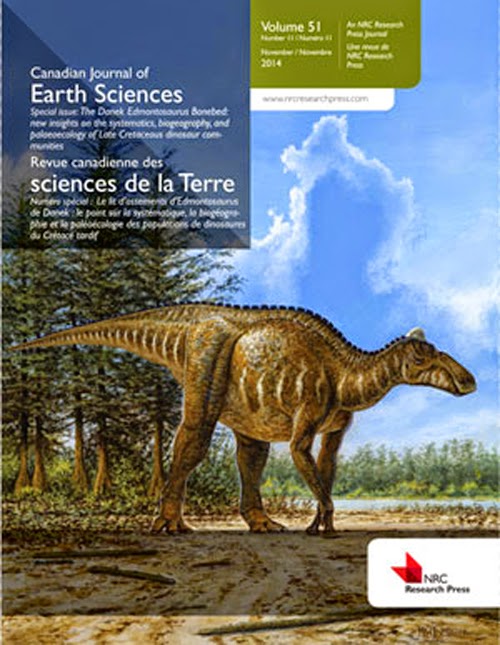
An exciting new special issue of the Canadian Journal of Earth Sciences shines the spotlight on the Danek Bonebed in Edmonton, Alberta and increases our knowledge of Edmonton’s urban dinosaurs, especially the iconic hadrosaurid Edmontosaurus.
Well-preserved, articulated dinosaur specimens often receive much attention from scientists and the public, but bonebeds provide a great deal of information that even the most spectacular articulated specimens cannot. Because of the amount of fossil material, the quality of preservation, ease of preparation, and volume of associated data, the site allows for a diversity of research projects tied together by a common theme.
Guest editors of this thematic issue featuring the Danek Bonebed include Victoria Arbour (University of Alberta), Michael Ryan (Cleveland Museum of Natural History) and Andrew Farke (Raymond M. Alf Museum of Paleontology) with support from Michael Burns, Eva Koppelhus and Phil Currie (from University of Alberta).
As the Special issue’s introduction explains:
“The bonebed was discovered by Danek Mozdzenski, an amateur fossil collector from Edmonton, on March 31, 1989 (Bell and Campione, 2014) and was initially excavated by the Royal Tyrrell Museum of Palaeontology in 1989 and 1991, during which time approximately 80 specimens were collected, including a partial articulated skeleton. The bonebed was reopened by the University of Alberta Laboratory for Vertebrate Palaeontology in 2006, and has since produced over 800 catalogued specimens.”
This issue’s 11 articles collect and share a wealth of information from the Danek Bonebed (Royal Tyrrell Museum of Palaeontology locality # L2379), which has proven to be an invaluable source of specimens for palaeontological research projects, and is important as a teaching and outreach tool.
In fact, a University of Alberta field course in vertebrate palaeontology centres on the Danek Bonebed, giving students a taste of field techniques, data collection, specimen curation and preservation, and allows them to work on original research projects. Many of the contributions in this special issue are derived from these small independent research projects.
At the Bonebed, participants excavate, prepare and research specimens and data that become part of the collections of the University of Alberta Laboratory of Vertebrate Paleontology. In addition, the condition of the material found there also lends itself well to relatively easy preparation by volunteers in a “Dino Lab” Volunteer Preparation Program. Volunteers range from university students to interested members of the public, and the program represents a significant form of public engagement and citizen science at the university.
Palaeontologists, graduate students, undergraduate students and volunteers have all played a role in the excavation, preparation, curation, research and display of dinosaur bones from the Danek Bonebed, and the editors are “grateful for their efforts in making this special issue of the Canadian Journal of Earth Sciences possible.”
Reference:
“The Danek Edmontosaurus Bonebed: new insights on the systematics, biogeography, and palaeoecology of Late Cretaceous dinosaur communities” www.nrcresearchpress.com/toc/cjes/51/11 special issue of the Canadian Journal of Earth Sciences was published today.
Note : The above story is based on materials provided by Canadian Science Publishing (NRC Research Press).










